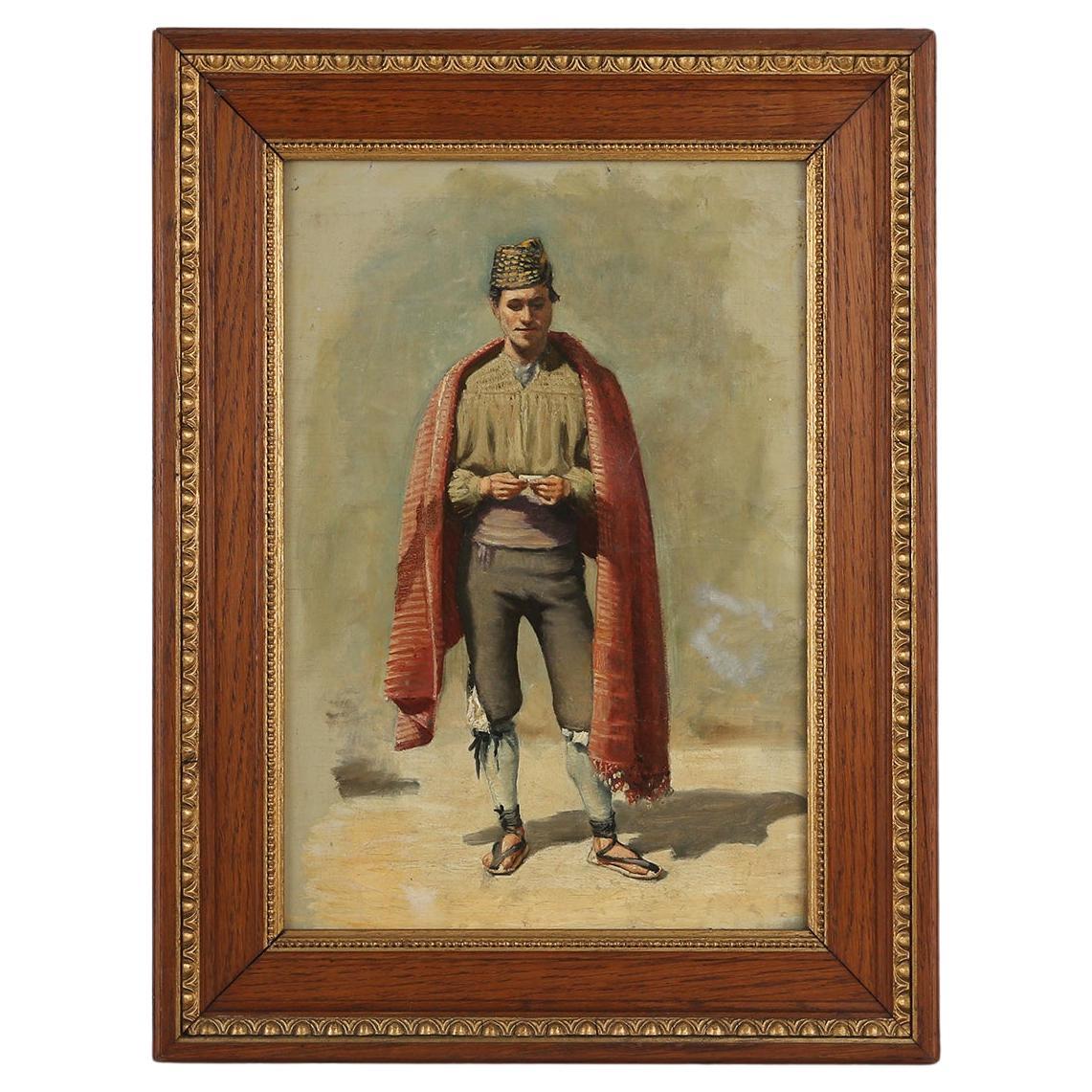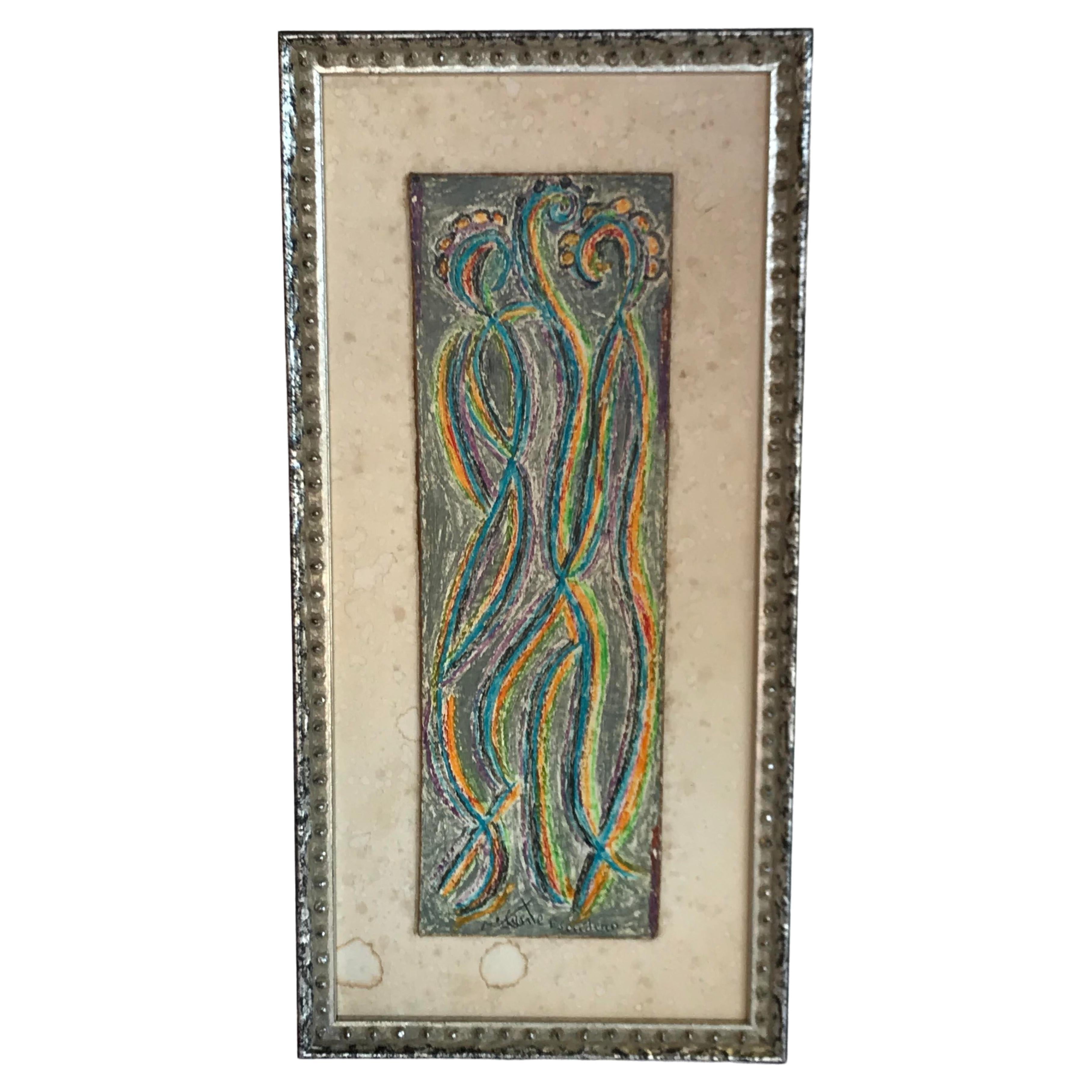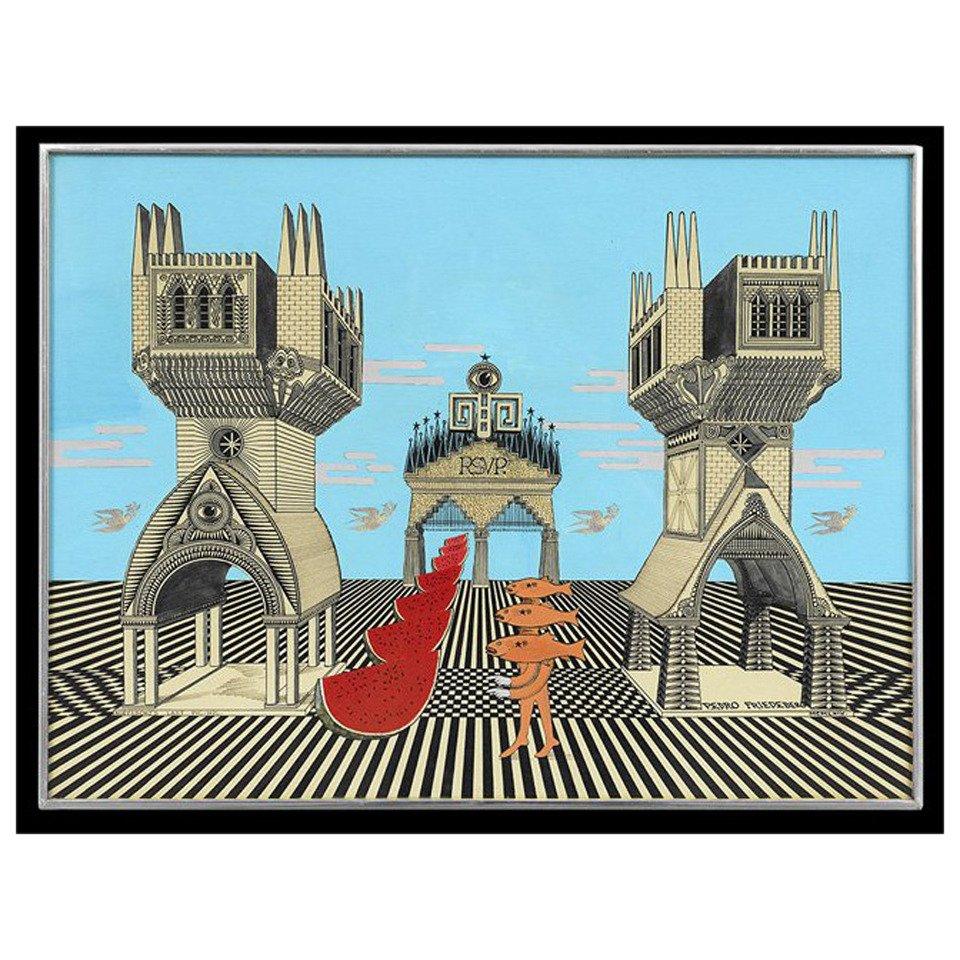Items Similar to Alexander Cañedo, Dancing Man, Surrealistic O/C Painting, ca. 1950’s
Want more images or videos?
Request additional images or videos from the seller
1 of 8
Alexander Cañedo, Dancing Man, Surrealistic O/C Painting, ca. 1950’s
About the Item
Mid-Century Surrealism
Alexander Cañedo
Dancing Man
Oil on Canvas
ca. 1950’s
PAINTING DIMENSIONS:
Canvas: 44 x 44 cm (17-3/8 x 17-3/8 in.)
Framed: 68 x 68 cm (26-3/4 x 26-3/4 in.)
Alexander Cañedo (Mexican-American, 1902 – 1978) was born in Mexico City as Alejandro de Cañedo; his father was a Mexican government official and his mother was from the United States. In 1918, when Cañedo was 15, his parents sent him to École nationale supérieure des Beaux-Arts in Paris where he studied under the sculptor Jean Magrou. In 1923, Cañedo traveled to Rome where he continued his art studies. In 1927, Cañedo briefly returned to Mexico. During that trip, the Mexican Government appointed him attaché to the Mexican Embassy in Rome.
In 1928, Cañedo held his first art exhibition with the Circolo Artistico in Rome, a collection of pencil drawings. More exhibitions followed in other cities in Europe. That same year, he traveled to the New York City where he exhibited widely. At this point, he began signing his work with just his last name; eventually, he also Anglicized his first name as "Alexander" and dropped the "de".
Cañedo was commissioned in 1929 to illustrate the amatory novel Orientale: The Adventure of Therese Beauchamps by the French author Francis de Miomandre. The highly stylized Art Deco results were so successful that he retained Cañedo the following year to illustrate his next novel, The Love Life of Venus.
In 1932, Cañedo was invited to have a solo show of his pencil drawings at Walter P. Chrysler, Junior's newly opened Cheshire Gallery, located in the Chrysler Building. He also had a solo exhibition at the Argent Galleries, and participated in shows of the Art Students League of New York, of which he was an active member.
By the mid-1930s, Cañedo began exhibiting watercolors. These were shown at solo exhibitions at the Arthur U. Newton Galleries. He expanded to work in oil paint and in the early 1940s, such work was exhibited at the Arthur U. Newton Galleries and the Schneider-Gabriel Galleries of New York. Beginning in 1947 and over the next decade, he produced many illustrations for the covers of science fiction magazines such as Astounding.
Traveling west, Cañedo held a solo show at Gump's Gallery in San Francisco in 1949, the first of many exhibitions at Gump's. That year, he also exhibited at the first annual Art League of California faculty show. In 1950, Walter Foster published an art instruction book titled How Cañedo Draws the Figure; it remained in print for five years.
Cañedo permanently relocated to California, dividing his time between San Francisco and Los Angeles, with frequent painting trips to the Monterey area. His work tended to be formally similar, with nude figures set in improbable, alien or abstracted landscapes, or featured natural objects such as seashells floating in such settings. During this time, Cañedo also produced many overtly homoerotic artworks for private collectors which were too suggestive to be exhibited in galleries.
His work remained in demand throughout the 1960s, with solo exhibitions at the James Pendleton Gallery, Galleria Gianni, Raymond & Raymond Gallery and the Arcade Gallery in the Beverly Hills Hotel. His works are included in the permanent collection of the Leslie Lohman Gay Art Foundation.
Cañedo died in West Hollywood, California on February 1, 1978
- Dimensions:Height: 17.38 in (44.15 cm)Width: 17.38 in (44.15 cm)Depth: 1 in (2.54 cm)
- Style:Mid-Century Modern (Of the Period)
- Materials and Techniques:
- Place of Origin:
- Period:
- Date of Manufacture:ca. 1950's
- Condition:Wear consistent with age and use. We make our best effort to provide a fair and descriptive condition report. Please examine photos attentively for they are an important part of the description. Send us a message to request more details or discuss price.
- Seller Location:New York, NY
- Reference Number:1stDibs: LU2819338834132
About the Seller
5.0
Vetted Seller
These experienced sellers undergo a comprehensive evaluation by our team of in-house experts.
Established in 1993
1stDibs seller since 2017
68 sales on 1stDibs
Typical response time: 2 hours
- ShippingRetrieving quote...Ships From: New York, NY
- Return PolicyA return for this item may be initiated within 10 days of delivery.
More From This SellerView All
- Modernist Oil on Canvas Portrait of a Boxer by Joe Stein, ca. 1950sLocated in New York, NYMARKINGS Signed ‘Joe Stein’ NOTE Original un-restored period frame has a Paris art gallery label affixed on the reverse. ABOUT PAINTING T...Category
Vintage 1950s American Mid-Century Modern Paintings
MaterialsCanvas
- Rolph Scarlett, Modernist Abstract Composition, Guache on Paper, Ca. 1950’sBy Rolph ScarlettLocated in New York, NYArtist: Rolph Scarletti (Canadian, 1889 – 1984) Object: Modernist Abstract Composition Period: Ca. 1950’s Medium: Guache on paper, framed Dimensions (unframed): Height: 9-1/3” Width: 12” Dimensions (framed): Height: 22-3/4”” Width: 25-3/4” Rolph Scarlett (Canadian, 1889 – 1984) was a consummate explorer of twentieth-century abstract painting. Never afraid of trying new styles, curious and opinionated, constantly engaged with the world around him while steadfastly aware that he was on his own path and his alone, Scarlett more than once proved to be at the artistic zeitgeist of the eras in which he lived. Exposed very early on to the work of Paul Klee through a chance meeting in Europe with the artist himself, Scarlett took up abstraction with a fervor that never diminished during his long and impressive career. To create something that had never existed before: this was Scarlett’s great cause. And that is what is most obvious when you look at Scarlett’s work—you have never seen anything quite like it. Scarlett was Canadian-born, came of age in the Midwest, and spent few important years in Hollywood, where he designed stage sets. His work from this early period echoes Klee’s use of color, his confidence in naïve, primitive forms, and his blend of abstraction and figuration. In its flat spatial qualities it prefigures the Indian Space painting of the 1940s by a decade. He moved to New York in 1933 and eventually found his first great patron at the Museum of Non-Objective Painting, directed by Baroness Hilla Rebay and art patron Solomon R. Guggenheim. Guggenheim would collect over 60 works by Scarlett for his collection, more than any other artist outside of Vasily Kandinsky and Rudolf Bauer. As a frequent exhibitor and lecturer at the Museum of Non-Objective Painting (MNOP), Scarlett honed his sensitive feel for bodies in space and capitalized on his trademark use of bright, vivacious colors into accomplished, perfectly harmonized geometric works. However, Scarlett soon morphed these hard-edged forms into a nuanced expressionistic abstraction which, at its best, seems to be populated by dancing forms that animate the canvases. Along this way he was advised by Rudolf Bauer, the German expatriate and one of the originators of non-objective painting in the teens. Bauer had the idea for the Museum, and Rebay, his champion, had found in Solomon Guggenheim a patron for manifesting it. When Bauer emigrated just before World War II, he wanted to meet Scarlett. The two became friends, and Bauer advised Scarlett on his work over the course of many years. Even in a 1979 interview, Scarlett began to tear up as he recalled his first meeting with Bauer, a man whose work he "worshipped," describing that, "It was a touching moment for me, I’ll tell you." Scarlett and Rebay also had a close, important relationship, one in which he bore the brunt of her sometimes condescending, if motherly, critiques and admonitions with tolerance and gratefulness. Eventually, though, he had to push back. In a letter from 1951 he writes, "I have noticed with growing amazement that during the past three years you have accepted less and less of my work—and, that same work, which you rejected has been accepted and shown in the best and largest shows all over this country." This period—the late 1940s to the early 1950s—did in fact correspond to Scarlett’s most critical success, and to a return to the fanciful forms and characters of his pre-war work. At the same time, he found his own rhythm and complexity using a drip style similar to, though denser and more opaque than, the one made famous by Jackson Pollock, who had worked for many years at the MNOP and with whom he shared common influences. In 1949 he had a very well received solo show in 1949 at the Jacques Seligmann Gallery, reviewed very favorably in The New York Times: "The impression made by these paintings is one of originality and strength." He was also included in a juried show "American Painting Today" at the Metropolitan Museum of Art in 1950 and in the Whitney Annual of 1951. The curator for the Whitney show in fact bypassed a selection of Scarlett’s careful geometrics in favor of a new "lyrical" drip painting—one which he describes as having had "a helluva good time" making. Rebay articulated her loss of control over Scarlett very keenly in one of her last official letters to him: "So your way ended in the horrid jungle it is in now; even a Mr. Pollock’s smearage was not bad enough for you to have a try at; and betraying yourself, you betrayed art and my faith in you, and my present disgrace by my failure to foresee such an outrageous possibility—since you even paint objectively now." Yet, despite the fact that he was moving in his own direction when the change in leadership took place at the Museum of Non-Objective Painting and Rebay was forced out as director, Scarlett was hit hard. He understood this change rightly as a betrayal by the establishment. Scarlett was a unique individual and soul, and was affected personally and philosophically by the idea that the movement with which Scarlett had aligned his talents seemed to disappear overnight, and his life’s work rendered valueless. Without the Museum’s support, Scarlett decided eventually to move to the artists’ community of Shady, New York, just outside of Woodstock. He had occasional shows throughout the years, but mostly settled down to regional obscurity. He began making jewelry, which had been his first trade, and it was following a show of his jewelry in 1975 at the Jaro Gallery, that he was rediscovered by Samuel Esses, and his wife Sandy. Samuel Esses was a successful businessman and an avid collector. He always sought out that which was unusual and, like Scarlett, was ahead of his time in many ways. For example, in 1979, Sam became enthralled with the early graffiti appearing on the New York subway trains. With the sole goal of preserving these groundbreaking yet short lived works of art he was inspired to create "The Esses Studio," a painting warehouse and workshop for graffiti artists to work in a studio, collaborate, and paint on canvas. The biggest names of graffiti writing participated—Futura, Crash, Dondi, Zephyr, and Daze to name a few. The project was well received and provided critical validation at an important time for this alternative form of abstraction to be recognized by the established art world. The success of the "Esses Studio" helped fuel an alternative fire that would propel gallerists and curators to acknowledge other street artists and provide a foundation of acceptance for the early careers of Keith Haring and Jean-Michel Basquiat. It is not a stretch to say that what Esses saw in the graffiti art of the 1970s was very similar to what he saw in 1950s-era Scarletts—something raw, honest, and melding many twentieth century influences into one unique form. Inspired by the importance of the collection and the passion of the collector, Weinstein Gallery...Category
Vintage 1950s Canadian Mid-Century Modern Paintings
MaterialsPaper
- Henry Carnier, Oriental Medina Street Scene, Original O/C Painting, Ca. 1880sLocated in New York, NYABOUT This eye-pleasing painting was created by the famous French painter, Henry Carnier (French, 1843-1902) around 1880s; that is, at the height of the Belle Époque artistic movem...Category
Antique 1880s French Belle Époque Paintings
MaterialsCanvas
- Richard Wilt, Caesar, American Mid-Century Modern O/C Painting, Ca. 1960sBy Richard WiltLocated in New York, NYABOUT ARTIST Richard Wilt (American, 1915 - 1981) > Chronology and Exhibition History 1915 Born in Tyrone, PA 1981 Died in Ann Arbor, MI EDUCATION: 1...Category
Vintage 1960s American Mid-Century Modern Paintings
MaterialsCanvas
- Nicolas Issaiev, Still Life with Fruits, Original Oil Painting, Ca. 1920’sBy Nikolai Alexandrovich IsaevLocated in New York, NYNicolas Issaiev (a/k/a Nikolai Alexandrovich Isaev, Russian-French, 1891-1977) was a painter, graphic artist, set designer, illustrator. In the early 1900s he studied in art scho...Category
Vintage 1920s French Expressionist Paintings
MaterialsCanvas
- David Anthony Tauszky, Portrait of a Chinese Woman, American Art Deco, ca. 1920sLocated in New York, NYDimensions: Height: 24” (61cm) Width: 20” (50.8cm) Frame width: 3.25” (8.12 cm) About: This very elegant painting is a part of the famous ‘Cantonese’ series of mainly female portraits, painter by David Anthony Tauszky...Category
Vintage 1920s American Art Deco Paintings
MaterialsPaint
You May Also Like
- Painting of a man Ca.1850Located in Meulebeke, BEAre you looking for a unique and beautiful work of art for your interior? Then this painting of a man in traditional dress might be for you. This pai...Category
Antique 1850s Spanish Mid-Century Modern Paintings
MaterialsCanvas, Wood
- "Reaching for the Stars, " Rare, Stunning Male Nude by Alexander CañedoBy Alexandro De CanedoLocated in Philadelphia, PAAuthor of "How Cañedo Draws the Figure" and one of the acknowledged masters of the nude in the Art Deco and Mid-Century periods, Alexander Cañedo pain...Category
Vintage 1940s American Art Deco Paintings
- 1950s "Flamenco Dancer" PaintingLocated in Charlottesville, VA1950s Crayon Painting titled Flamenco Dancer. A small piece that will be a pleasure to own.Category
Vintage 1950s Paintings
MaterialsPaper, Crayon
- 1950's French Modernist/ Cubist Painting, Bearded Man PortraitLocated in Cirencester, GBFrench Landscape by Bernard Labbe (French mid 20th century) original watercolour/ gouache painting on board, unframed size: 13.5 x 9.5 inches condition: very good and ready to be...Category
Vintage 1950s French Mid-Century Modern Paintings
MaterialsOther
- Dancers Painting by Bagong Kussudiardja, Indonesia, 1950sBy Bagong KussudiardjaLocated in Antwerp, BEDancers. Oil on canvas painting with dancing people signed by Bagong Kussudiardja. Indonesia, 1928-2004. Dimensions including the wooden ...Category
Mid-20th Century Indonesian Mid-Century Modern Paintings
MaterialsWood
- Framed Surrealistic Painting by Pedro FriedebergBy Pedro FriedebergLocated in Atlanta, GAArtists: Pedro Friedeberg (Mexican, b. 1936) Title: "Nietzche's Last Picnic" Year: 1969 Medium: oil, pen and ink on board Size: 15 x 20" Marked: signed and dated "MCMLXIX" mid-...Category
Vintage 1960s Mexican Modern Paintings
MaterialsPaint





